|
|

This chapter describes the Cisco Metro 1500 series metropolitan area network (MAN) dense wavelength division multiplexing (DWDM) system, and includes the following sections:
The Cisco Metro 1500 series system expands the distance and application capabilities of existing local area networks (LANs), metropolitan area networks (MANs), and storage area networks (SANs). It is protocol-independent and can support virtually any fiber-optic device.
The Cisco Metro 1500 series operates using the International Telecommunication Union (ITU) wavelength grid of 200-GHz channel spacing. It receives the signal from the local device and converts it to the desired wavelength. Only single-mode fibers (remote or trunk fibers) are used for multiplexed data transmission.
The Cisco Metro 1500 series system provides communication within a broad range of data rates, up to 2.488 Gbps, and within a guaranteed optical budget. The system is transparent to any data communication protocol except wavelength channel modules (WCMs) with clock recovery. For more details on data rates, optical budgets, and supported protocols, see "Specifications."
The Cisco Metro 1500 series system also provides monitoring and service functions such as loss of light and bit-rate control, as well as local and remote loopback.
DWDM technology allows different channels to be combined for transportation over one fiber pair. A pair of multiplexer (MUX) and demultiplexer (DMX) modules assemble the channels into four groups of up to eight channels. The band splitter module (BSM) assembles and disassembles the four groups for the two remote fibers.
Figure 1-1 shows the multiplexer architecture.
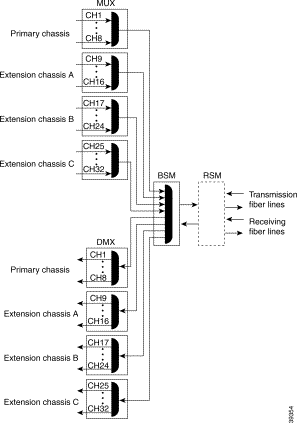
The Cisco Metro 1500 series system has a modular structure so you can expand the system while it is in use. Adding or removing channels does not affect the other working channels. Figure 1-2 shows a typical Cisco Metro 1500 series system configuration containing a primary chassis and three extension chassis.

The Cisco Metro 1500 series system requires two identical WCMs to complete a full communications link, one at each end of the link. Each system unit includes a primary chassis (see Figure 1-3) that holds up to eight WCMs. The WCMs transport up to eight independent channels.

The Cisco Metro 1500 series system can be expanded by adding more WCMs. Adding extension chassis A, B, and C (Figure 1-4 to Figure 1-6) at both ends of the communications link upgrades the system to transport a total of 32 independent channels. A network element management interface (NEMI) can control up to two chassis and up to four NEMIs can be combined through an Ethernet hub or switch to appear as a single system as seen by a Network Management System (NMS). We recommend that you initially install the primary chassis and extension chassis A, which holds the BSM, to avoid service interruption while upgrading the unit to more than eight channels. The primary chassis and the extension chassis are each equipped with two fully redundant load-sharing, hot-swappable power supply modules (PSMs), as shown in Figure 1-3 to Figure 1-6.



Figure 1-7 shows the rear view of the primary chassis and extension chassis.
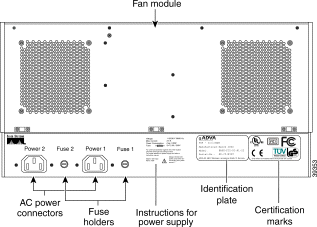
Each chassis is delivered with one to eight WCMs, according to the configuration ordered. Each WCM provides the conversion of the local or remote channels to their respective wavelengths. All modules are hot-swappable and can be repaired or upgraded while the other WCMs are in use. WCMs support a wide range of data rates. For more information on data rates, optical budgets, and supported protocols, see "Specifications," and "Unit Maintenance and Network Record."
The RSM is available as an option. The RSM provides the system with 1+1 line protection and is installed in the primary chassis only. (See Figure 1-3).
The primary chassis and extension chassis B also include the network element management interface (NEMI) module. Extension chassis A and C includes an optional device element management interface (DEMI) module. For information on the NEMI and DEMI, refer to the Cisco Metro 1500 Series Software Configuration Guide.
Each WCM has fiber-optic cables attached to its front panel. The remote lines of each WCM are connected to the MUX and DMX of the chassis. The common input and output connections of MUXs and DMXs (M1 to M4/D1 to D4) are connected to the BSM (M1 to M4/D1 to D4) in extension chassis A. For more information on the MUX/DMX modules, see the "Multiplexer and Demultiplexer Modules" section. The common input or output of the BSM (MUX/DMX) can be connected to the RSM receiver or transmitter (MUX/DMX) connector. The signals of the remote link are then present at the line A and line B connectors of the RSM.
Each chassis of the Cisco Metro 1500 series can be mounted in a 19-inch cabinet or in open racks. Each chassis requires five rack units. The chassis houses all of the system modules required to achieve the optical communications link.
This section describes the following chassis components:
The housing is modular in accordance with DIN specification 41494 part 5. The construction comprises two aluminum sides and four aluminum cross extrusions. Standard features also include sheet-steel covers and die-cast aluminum cover extrusions. All covers are uncoated aluminum; cross extrusions, side extrusions, and handles are textured powder-coated. Figure 1-8 shows the dimensions of the chassis.

A label at the back of the unit identifies the system. Each WCM, RSM, and NEMI have unique serial numbers and specification codes printed on the front panels of the modules.
WCMs are labeled with alphanumeric and pictographic descriptions of their main properties. Table 1-1 provides descriptions of the WCM labels.
| Main Properties | Specification |
|---|---|

| WCM with clock recovery. The clock recovery is fixed to a single frequency as indicated below the symbol. |

| WCM with clock recovery. The clock recovery can be set to three frequencies. These frequencies are shown above and below the symbol. |

| Transparent WCM without clock recovery ranging from 100 to 1250 Mbps. |

| Local port description of WCM. Fiber type is multimode and the communication wavelength is 1310 nm. |

| Remote port description of WCM. Fiber type is single-mode and the communication wavelength is 1550 nm. |

| TDM4E with clock recovery. The clock recovery is fixed to a single frequency as indicated below the symbol. |
The state of the fan module can either be observed through the NEMI-master or it can be read off the fan LEDs at the front side of the chassis. A green light indicates that everything is in working order. A red light signals that either a fan or a fan power supply is not working properly, which does not necessarily endanger the functioning of the air flow system because there are backup fans and fan power supplies. Refer to the Cisco Metro 1500 Series Software Configuration Guide for more information about fan observation using the NEMI-master. The ocmstate-f provides information on the fans.
You can check the fan module status on the display panel at the front of the chassis and through the NEMI. For more information about using the NEMI to check the fan status, refer to the Cisco Metro 1500 Series Software Configuration Guide.
 |
Caution The fan system can only be replaced by Cisco-trained and -certified technicians. |
The Cisco Metro 1500 series system provides high reliability in data and telecommunication applications because it has two identical, fully redundant power supplies. Each power supply can take over the power needs of the entire system. These power supplies provide 5V at 30A to the system, and full input-to-output, input-to-case, and output-to-output isolation. For detailed information on the power supply and how to replace it, see the "Determining Power Supply Status" section.
The state of the PSMs can either be observed through the NEMI-Master or it can be read off the LEDs at the front side of the frame. If both PSMs are working the green or red power LED is lit, otherwise there is no light at all.
This section describes the following system modules:
 |
Note The network element management interface (NEMI) and the device element management interface (DEMI) are described in the Cisco Metro 1500 Series Software Configuration Guide. |
The Cisco Metro 1500 series system uses the technology of Dense Wavelength Division Multiplexing (DWDM) to optimize usage of available optical fibers. WCMs convert the local optical signals to separate wavelengths of the ITU-T grid necessary for DWDM. The MUX is a passive high performance module which integrates up to eight optical signals into one wavelength band for transportation through the BSM on one single-mode fiber (Figure 2-13).
The DMX receives the wavelength band from the corresponding MUX at the remote end of the link via the BSM. In the DMX, the wavelength band is split into separate wavelength channels that are transferred to the WCMs for reconversion into the customer application signal as shown in Figure 2-13.
Table 1-2 lists the seven WCMs that are available for the Cisco Metro 1500 series system, their part numbers, and their maximum remote receiver (R/R) input power in decibels per milliwatt (dBm).
| WCM | Part Number | Maximum R/R1 Input Power |
|---|---|---|
Low-speed transparent | WCM/LS-T | -5 dBm2 |
High-speed transparent | WCM/HS-T | -7 dBm |
High-speed | WCM/HS-FC622 | -7 dBm |
High-speed | WCM/HS-FC1062-CL | -7 dBm |
High-speed | WCM/HS-MC1062/1250 | -7 dBm |
2.488 Gbps | WCM-FC2488 | -8 dBm |
| 1R/R = remote receiver 2dBm = decibels referenced to 1 mW — the standard unit of normalized power level used in optics, where 0 dBm =1 mW, +10 dBm =10 mW. |
WCMs are used in pairs. Adding a channel to a communication link requires adding WCMs of the same type and channel number at both ends of the link. The available WCM types are either data rate transparent or they have clock recovery through a fixed or a settable multiclock.
The status of receivers and transmitters can be observed locally with SNMP-based network management tools. In addition, the front panel LEDs provide information on the operating status. Refer to the Cisco Metro 1500 Series Software Configuration Guide for more information about this feature.
For service purposes, data can be looped. The loop function is switchable using the network management tools. A local loop connects the electrical output of the local optical receiver with the electrical input of the local optical transmitter. This loop enables a test of the local transmission lines, the local receiver, and the local transmitter. Locally arriving data is directly sent back. A remote loop connects the electrical output of the optical receiver at the remote system to the electrical input of the optical transmitter, so that the data sent to the remote system is directly retransmitted to the local system. This loop enables a test of the remote transmission lines, the MUX/ DMX pair, the remote receiver and remote transmitter pair, and the remote system.
The following transparent WCMs are available:
These WCMs are protocol-transparent, and they support their data rates within a guaranteed optical budget. Locally received optical data enters the local receiver and is electrically transferred to the remote transceiver. It transmits this data in optical form at a certain ITU wavelength into the MUX, which sends the data to the system at the other side of the link. There, the optical data enters first the DMX and then the remote receiver of the system. The data then is electrically transmitted to the local transmitter, which delivers the optical data.
Remotely received optical data from the paired WCMs enters through the DMX into the remote receiver at a specific ITU wavelength. The data is then electrically transmitted to the local transmitter, which delivers the optical data.
You can check the status of receivers and transmitters using the front panel LEDs or with SNMP-based network management tools. For more information on the available network management tools, refer to the Cisco Metro 1500 Series Software Configuration Guide.
The WCM LEDs provide information about its operating status. Table 1-3 describes the LEDs.
| Label | Color1 | Description |
|---|---|---|
On/Err | Green | Power is on. No software or hardware errors are detected. |
Red | A hardware or software error was detected or the initialization is in progress (during system startup only). | |
Red blinking | WCM is in manual setting mode (not shown in case of error). | |
Loop | Orange | A remote and/or a local loop is established. |
L/R | Green | Data is received from the local port. |
L/T | Green | Data is transmitted to the local port. |
R/R | Green | Data is received from the remote end of the link. |
R/T | Green | Data is transmitted to the remote end of the link. |
Green blinking | WCM is in ALS mode; LED blinks once every 10 seconds. |
| 1Any other state than the ones listed indicates a possible failure in the local system. |
The following transparent WCMs are available with fixed clock recovery:
 |
Note WCMs with settable clock recovery are also available. See the "WCMs with Settable Clock Recovery" section. |
Only signals with the designated data rate can be transmitted within a guaranteed optical budget.
The WCM LEDs provide information about its operating status. Table 1-4 describes the LEDs.
| Label | Color1 | Description |
|---|---|---|
On/Err | Green | Power is on. No software or hardware errors are detected. |
Red | A hardware or software error was detected or the initialization is in progress (during system startup only). | |
Red blinking | WCM is in manual setting mode (not shown in case of error). | |
Loop | Orange | A remote and/or a local loop is established. |
L/R | Green | Data is received from a local port and the data rate matches the clock frequency. |
Yellow | Data is received from a local port but the data rate does not match the clock recovery frequency. | |
L/T | Green | Data is transmitted to a local port. |
R/R | Green | Data is received from the remote end of the link. |
R/T | Green | Data is transmitted to the remote end of the link. |
Green blinking | WCM is in ALS mode; LED blinks once every 10 seconds. | |
| Off | Data stream is interrupted because the clock frequency does not match the current data rate. |
| 1Any other state than the ones listed indicates a possible failure in the local system. |
Locally received optical data enters the local receiver and is electrically transferred to the remote transmitter using clock-recovery. The clock recovery locks onto the edges of the data signal and restores the signal to the chosen data transmission frequency. The remote transmitter transmits the data in optical form at a certain ITU wavelength to the MUX.
Optical data that is sent by the module on the remote side enters the remote receiver of the local system through the DMX. The data is then electrically transmitted to the local transmitter, which delivers the optical data.
The following transparent WCMs are available with settable clock recovery:
These WCMs are similar to the WCMs with clock recovery with the exception that you can change the clock recovery data rate of WCMs with multiclocks.
You can set the clock recovery data rate using network management tools. For more information, refer to the Cisco Metro 1500 Series Software Configuration Guide.
 |
Note Be sure to set and enable clocks, disable loopback, and enable automatic mode for the RSM before installing and enabling the Cisco Metro 1500 series systems. |
See the "Clock Recovery Front Panel LEDs" section for LED descriptions.
Four optical connectors are located on the front panel of the WCM:
Use MiniSC connectors, also called MUPC connectors. See the "Connecting WCMs to MUX and DMX Modules" section for more information. The front panel of the WCM is shown in Figure 1-9.
 |
Note Some WCMs have a sticker in the middle of the faceplate with the channel number, release status, and wavelength and fiber type of the local and remote ports. |

The Cisco Metro 1500 series system uses DWDM technology to convert channels of optical communication into separate wavelengths of the ITU-T grid. The multiplexer (MUX) module combines several optical signals into a combined signal for transportation using one single-mode fiber. The demultiplexer (DMX) module receives the combined signal from the MUX at the remote end of the link. In the DMX, the combined optical signal is separated and fed into eight different fibers. These signals are then transferred to the WCMs for reconversion into the customer's application signal. Figure 1-10 shows the locations of the MUX and DMX in the chassis.

Each MUX and DMX has up to 10 optical connectors:
Use MiniSC type connectors. Figure 1-11 shows the front panels of the MUX and DMX. See the "Connecting WCMs to MUX and DMX Modules" section and "Connecting BSMs with MUX and DMX Modules" section for more information.
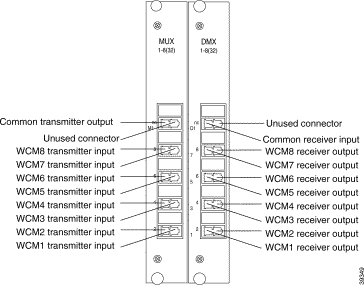
The Cisco Metro 1500 series system uses four channel groups consisting of eight channels of data communication. The band splitter module (BSM) combines and splits these groups of multiplexed optical channels. The group signals from the MUX modules are combined and routed to the input ports and then are multiplexed for data transmission through one fiber to the BSM at the remote side of the link. Simultaneously, the BSM receives the combined signal at its remote input from the remote side of the link. This mixed signal is split into four groups for demultiplexing in the DMX modules.
The BSM is installed in chassis A to avoid service interruption on upgrading the unit to more than 16-channel WCM or 8-channel TDM4E, respectively. This also means that if you only have the primary chassis, you need a chassis A to install a BSM.
The BSM has up to 10 optical connectors:
All connectors are of the MiniSC type. Figure 1-12 shows the front panel of the BSM. Connecting the BSM is described in the "Connecting BSMs with MUX and DMX Modules" section and in the "Connecting a BSM to an RSM" section.
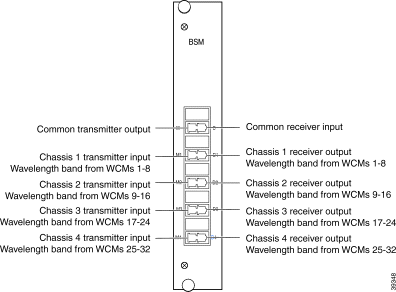
The Cisco Metro 1500 series system can be equipped with an optional optical switch, or remote switch module (RSM), that enhances the system with 1+1 line protection capabilities.
The transmitter and the receiver of the band splitter module (BSM) are single-mode fibers attached to the corresponding connectors of the RSM. The RSM links the communication to one of its remote lines with two fibers each. The active line of the RSM operates as the standard communication path and the other line is the backup path. The backup line is observed continuously. If communication is interrupted in the standard line, the RSM links the communication to the backup line automatically. Switching occurs in less than 50 ms. After switching, the former backup line, now the active line, operates as the standard line and the broken line becomes the backup line. The RSM does not switch back when the backup line recovers.
The RSM can be controlled locally with push buttons at the front panel and remotely using the network element management interface (NEMI) and network management software. For more information on the NEMI, refer to the Cisco Metro 1500 Series Software Configuration Guide. Figure 1-13 shows the RSM front panel with its optical connectors.
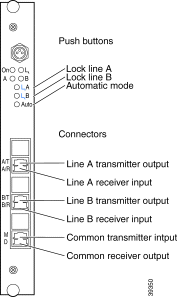
Three push buttons control the RSM. Table 1-5 lists each push button and its function.
| Label | Description |
|---|---|
Lk A | Locks the RSM on line A. |
Lk B | Locks the RSM on line B. |
Auto | Switches the RSM to automatic mode. |
Four LEDs indicate the status of the RSM. Table 1-6 describes these LEDs.
| Label | Color | Description |
|---|---|---|
On | Green | Power is on. No error is detected. |
Red, continuous | A hardware error is detected. | |
Red, blinking | Loss of signal is detected on both remote lines of the RSM. Both remote lines are broken or a hardware error is detected. | |
A | Green | Line A is active. |
Green, blinking | Line A is inactive. A takeover of the communication is possible. | |
Red | Line A is broken and active. | |
Red, blinking | Line A is broken and inactive. | |
B | Green | Line B is active. |
Green, blinking | Line B is inactive. A takeover of the communication is possible. | |
Red | Line B is broken. | |
Lk | Yellow | RSM is locked to one line. No automatic switching is possible. |
Table 1-7 lists the six optical connectors of the RSM. Figure 1-13 shows the front panel of the RSM and its optical connectors.
| Label1 | Description |
|---|---|
A/T | Line A transmitter |
A/R | Line A receiver |
B/T | Line B transmitter |
B/R | Line B receiver |
D | Transmitter output to the BSM |
M | Receiver input from BSM |
| 1All connectors are of the MiniSC type. |
The RSM ships set to automatic mode and line A is the active line. Line B is the backup line. By default, the RSM does not save its last setting in the event of a power loss.
After power on, the RSM is set to automatic mode and one line is the active line while the other line operates as backup line. The RSM permanently monitors the availability of both line A and line B.
If line A breaks and the backup line (line B) is functioning, the RSM links the communication to line B. After line A recovers no further switching takes place. Line B continues to operate as the active line and line A as the backup line. The same applies when the active line B breaks.
The RSM monitors the accessibility of the backup line. If line A breaks and if line B is functional, the RSM links the communication to line B.
If line A is the active line and you lock the RSM to line B, the RSM checks the accessibility of line B. If line B is functional, the RSM switches the communication to line B and holds the communication on this line. Automatic switching to the backup line (line A) is stopped. If line B is broken, the RSM cannot be locked to line B.
If line B is the active line and you lock the RSM on line B, no switching takes place. The communication is locked on line B. Any automatic switching to the backup line (line A) is stopped.
If line B is the active line and you lock the RSM to line A, the RSM checks the accessibility of line A. If line A is functional, the RSM switches the communication to line A and holds the communication on this line. Any automatic switching to the backup line (line B) is stopped. If line A is broken, the RSM cannot be locked on line A.
At any time, the RSM can be switched from lock mode to automatic mode.
If neither line A nor line B is connected to the RSM or both lines are broken, the red on LED blinks. Also, line A and line B LEDs are red as a visual signal to check for disconnected lines.
The push buttons below the LEDs allow you to switch between automatic mode and lock mode. Lock mode can be enabled for either line A or line B. If the lock mode for one line is activated, the communication cannot be automatically switched to the other line.
Lock mode can be enabled either for an active line or for a backup line. If the active line is locked, the communication cannot be switched to the backup line. If lock mode is enabled for a current backup line by pressing the respective button, the RSM checks the availability of the backup line and (if the line is in working order) switches the communication to it, so that it becomes the active line and locks it. Now, automatic switching to the backup line is impossible.
If the red on LED blinks and one of the A and B LEDs is red while the other one is flashing red, this indicates two possible situations: neither line A nor line B are connected to the RSM or both lines are broken. In this situation, the lock mode can be activated once for testing purposes.
The Cisco Metro 1500 series system can be equipped with an optional time-division multiplexing 4 x ESCON (TDM4E) wavelength channel module. The TDM4E uses TDM technology to provide a transmission capacity four times higher than conventional WCMs. TDM technology allows you to combine 4 200 MB ESCON channels into one WDM channel, making optimal use of the available fiber bandwidth.
 |
Note ESCON (Enterprise System Connection) is an IBM registered trademark. |
Each TDM4E contains four submodules (or interfaces) that guarantee optical receiving and transmission. These optical ESCON interfaces are connected to the MUX/DMX unit on the main board of the TDM4E. The MUX/DMX modules electrically multiplex and demultiplex asynchronously up to four ESCON channels to one optical channel for transmission.
The remote transmitter (R/T) generates the optical output signal and feeds it into the remote line. The remote receiver (R/R) receives the optical signal from the remote end of the communication link, converts it into an electrical signal, and then transfers it to the MUX/DMX module. Figure 1-14 shows a typical TDM4E system configuration.

The local ports use multimode fibers. Remote data is transmitted bidirectionally using single-mode fiber only.
All TDM4Es can be replaced or added at any time during operation of the system. Setting up a communication link requires a pair of fully identical TDM4Es. Up to four channels of optical communication of the TDM4E are converted to separate wavelengths of the ITU-T grid for DWDM.
The multiplexer module (MUX) combines the optical signals into a combined signal for transportation using one single-mode fiber to the optional remote switch module (RSM). The RSM enhances the system with a 1 + 1 line protection. The demultiplexer module (DMX) receives the combined signal from the optional RSM. In the DMX, the combined optical signal is separated into the original wavelengths of optical communication. These signals are then transferred to the TDM4Es for reconversion into the application signal. (See Figure 1-15.) The TDM4Es support the 200 Mbit/s clock rate used by the ESCON protocol.

On the front panel of the TDM4E there are 10 MiniSC type optical connectors:
Figure 1-16 shows the optical connectors on the front panel of the TDM4E.

TheTDM4E LEDs provide information about its operating status. The Gigabit Ethernet connection is typically equipped on the remote receiver side with a fixed clock rate of 1250 mbit/s. A complete loss of optical signal on the remote receiver causes the remote laser to automatically shut down.
Table 1-8 describes the functions of each LED. If the system is operational and all interfaces are properly connected, all active TDM4E receive and transmit LEDs are continuously on.
| Label | Color | Description |
|---|---|---|
On | Green | Power is supplied to the TDM4E. |
LR4 | Solid green | Data is received from a local port. Data rate matches clock frequency. |
Solid yellow | Data is received from a local port. Data rate does not match clock frequency and the local clock is unlocked. | |
LR3 | Solid green | Data is received from a local port. Data rate matches clock frequency. |
Solid yellow | Data is received from a local port. Data rate does not match clock frequency and the local clock is unlocked. | |
LR2 | Solid green | Data is received from a local port. Data rate matches clock frequency. |
Solid yellow | Data is received from a local port. Data rate does not match clock frequency and the local clock is unlocked. | |
LR1 | Solid green | Data is received from a local port. Data rate matches clock frequency. |
Solid yellow | Data is received from a local port. Data rate does not match clock frequency and the local clock is unlocked. | |
LT4 | Green | Data is transmitted to a local port. |
LT3 | Green | Data is transmitted to a local port. |
LT2 | Green | Data is transmitted to a local port. |
LT1 | Green | Data is transmitted to a local port. |
R/T | Green | Data is transmitted to the remote end of the link, or the remote laser is forced on. |
Blinking yellow/red | Remote laser is forced on while local loop is activated. | |
R/T | Flashing green | ALS1 occurred when the green LED flashes every 10 seconds. |
R/T | Yellow | Local loop is activated. |
R/R | Green | Data is received from the remote end of the link. Data rate matches the clock frequency. The remote transmitter from the remote end of the link and the remote receiver from the local end are synchronized |
| Yellow | Data is received from the remote end of the link. Data rate matches the clock frequency, but the remote transmitter from the remote end of the link and the remote receiver from the local end are not synchronized. |
ERR | Solid red | An error has occurred. |
| 1ALS = automatic laser shutdown |
The NEMI is a two-slot plug-in module that can be configured by software to be either a NEMI-master or a NEMI-slave. The NEMI resides in the following chassis: in the primary chassis (Figures 2-3 and 2-4), chassis B (Figure 2-6), chassis D, and chassis F. This interface provides status and configuration capabilities.
Systems with 24 to 32 channels require the installation of a second NEMI module in extension chassis B. When the two NEMI modules are interconnected using an inter-NEMI network connection (INNC), one NEMI module is configured as the NEMI-master, while the second is configured as the NEMI-slave.
 |
Note The NEMI-master and the NEMI-slave are physically identical modules and differ only in software configuration. |
The physical location of the NEMI module (either master or slave) in the chassis is the same. See Figure 1-17.
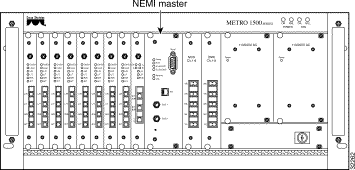
Each NEMI module contains four ports:
You can use bus interconnect ports to connect the NEMI-master or the NEMI-slave with the corresponding DEMI module using external bus cables. The front panel of the NEMI is shown in Figure 1-18.

Table 1-9 describes the functions of the LEDs shown in Figure 1-18.
| LED | Color | Description |
|---|---|---|
Power | Green | Power is on. |
Error | Red | An error is occurring. |
Err. Int. BUS | Red | An error on the internal bus is occurring. |
Err. Ext. BUS | Red | An error on the external bus is occurring. |
Receive | Blinking green | Link is active; traffic is on the network. |
Link | Green | Link is established. The 10BASE-T network link is established. |
For more information about NEMIs, refer to the Cisco Metro 1500 Series Software Configuration Guide.
The device element management interface (DEMI) is a single-slot module that resides in chassis A, C, E, and G. This interface provides status and configuration capabilities of the extension frame in which it is installed to the corresponding NEMI. A DEMI module is needed to administer systems with more than 8 WCMs or 4 TDM4Es. A DEMI and a NEMI have to be linked by an external bus cable. The DEMI module provides the following:
Systems with 24 to 32 channels require the installation of a second DEMI in extension chassis C.
The DEMI module in extension chassis A connects to the NEMI-master module in the primary chassis. The DEMI module in extension chassis C connects to the NEMI-slave module in extension chassis B.
The physical location of the DEMI module is shown in Figure 1-19.

Each DEMI contains three bus interconnect ports. The unlabeled bus interconnect port at the top of the DEMI module is not currently implemented. The other ports are labeled BUS1 and BUS2. You can interconnect the DEMI to a NEMI using an external bus cable.
Figure 1-20 shows the front panel of the DEMI.

Table 1-10 describes the functions of the LEDs shown in Figure 1-20.
| LED | Color | Description |
On | Green | DEMI is on. |
Err | Red | An error is occurring. |
For more information about DEMIs, refer to the Cisco Metro 1500 Series Software Configuration Guide.
An Ethernet hub is necessary in systems consisting of more than two chassis. The hub is used to connect two or more NEMIs with each other and the Network Management System (NMS). It allows network management from a single point in the network.
![]()
![]()
![]()
![]()
![]()
![]()
![]()
![]()
Posted: Fri Aug 2 14:43:52 PDT 2002
All contents are Copyright © 1992--2002 Cisco Systems, Inc. All rights reserved.
Important Notices and Privacy Statement.